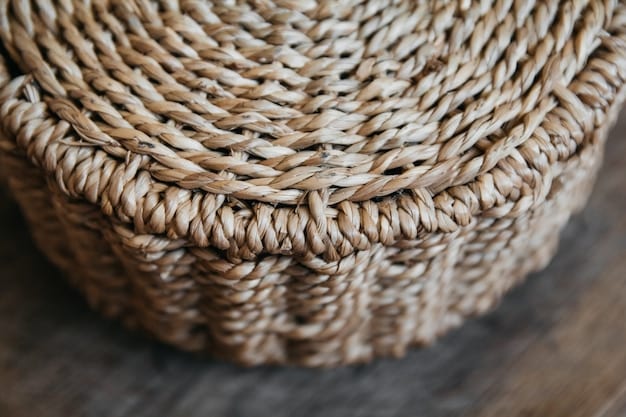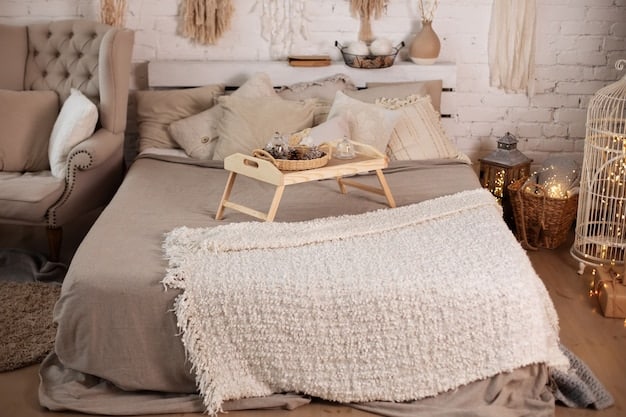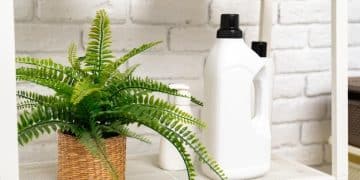Eco-Friendly Home Decor: Sustainable Materials for a Greener Home

Eco-friendly home decor involves selecting sustainable materials like bamboo, reclaimed wood, and organic cotton to create a healthier and more environmentally responsible living space, minimizing your ecological footprint.
Looking to create a beautiful and healthy home without harming the planet? Discover the world of **eco-friendly home decor**, where style meets sustainability, and transform your space with stunning, earth-conscious materials.
What is Eco-Friendly Home Decor?
Eco-friendly home decor is more than just a trend; it’s a conscious choice to minimize your environmental impact while creating a beautiful and comfortable living space. It involves selecting materials, furniture, and decorative items that are sustainable, durable, and ethically produced.
Essentially, it’s about making informed decisions that benefit both your home and the environment.
The Importance of Sustainable Choices
Choosing sustainable materials can significantly reduce your carbon footprint. Traditional home decor often relies on resources that contribute to deforestation, pollution, and waste. By opting for eco-friendly alternatives, you’re supporting responsible practices and helping to preserve natural resources.
- Reduced Carbon Footprint: Sustainable materials often require less energy to produce and transport, reducing your overall carbon footprint.
- Healthier Indoor Air Quality: Many eco-friendly materials are free from harmful chemicals and toxins, improving your home’s air quality.
- Support for Ethical Practices: Choosing sustainable products supports fair labor practices and responsible production methods.
Ultimately, eco-friendly home decor is about creating a space that is both beautiful and sustainable, contributing to a healthier planet for future generations.

Top Sustainable Materials for Home Decor
Selecting the right materials is crucial when embracing eco-friendly home decor. Fortunately, there are many options available that are both sustainable and stylish. Here are some of the top sustainable materials to consider:
These materials not only look great but also contribute to a healthier indoor environment.
Bamboo: A Versatile and Renewable Resource
Bamboo is a fast-growing, renewable resource that makes an excellent alternative to traditional wood. It’s incredibly strong and durable, making it suitable for furniture, flooring, and even decorative items.
- Rapid Growth: Bamboo is one of the fastest-growing plants on Earth, making it a highly sustainable option.
- Durability: Bamboo is naturally strong and resistant to moisture, making it ideal for various home decor applications.
- Versatility: Bamboo can be used for flooring, furniture, blinds, and even kitchen utensils.
With its versatility and eco-friendly properties, bamboo is a fantastic choice for any room in your home.
Reclaimed Wood: Giving New Life to Old Materials
Reclaimed wood is wood that has been salvaged from old buildings, barns, and other structures. By using reclaimed wood, you’re not only adding character and history to your home but also reducing the demand for newly harvested timber.
Reclaimed wood offers a unique aesthetic and a story behind every piece.
Benefits of Using Reclaimed Wood
Using reclaimed wood in your home decor comes with numerous benefits beyond its unique aesthetic appeal. Here are some of the key advantages:
- Reduces Deforestation: By repurposing existing wood, you’re helping to reduce the need to cut down new trees.
- Unique Character: Reclaimed wood often has a unique patina and character that can’t be replicated with new materials.
- Durability: Older wood is often denser and more durable than new wood, making it a long-lasting choice.
Choosing reclaimed wood allows you to create a space that is both stylish and environmentally responsible.

Organic Cotton and Linen: Natural Textiles for a Healthy Home
When it comes to textiles, organic cotton and linen are excellent choices for eco-friendly home decor. These natural fibers are grown without the use of harmful pesticides and chemicals, making them safer for both you and the environment.
Switching to organic cotton and linen can improve your home’s air quality and reduce your exposure to toxins.
Uses of Organic Cotton and Linen
Organic cotton and linen can be used in various applications throughout your home. Here’s how you can incorporate these textiles:
- Bedding: Choose organic cotton or linen sheets, duvet covers, and pillowcases for a comfortable and healthy sleep environment.
- Curtains and Drapes: Opt for linen or organic cotton curtains to filter natural light and add a touch of elegance to your rooms.
- Upholstery: Consider upholstery made from organic cotton or linen for your sofas, chairs, and other furniture pieces.
By choosing organic cotton and linen, you’re making a conscious decision to support sustainable agriculture and reduce your exposure to harmful chemicals.
Recycled Glass and Metal: Sustainable Decorative Accents
Recycled glass and metal are fantastic options for sustainable decorative accents. These materials can be transformed into beautiful and unique items, reducing waste and conserving resources.
Using recycled materials adds a touch of creativity and innovation to your home decor.
Decorating with Recycled Glass and Metal
Here are some ideas for incorporating recycled glass and metal into your home decor:
- Vases and Bowls: Look for vases and bowls made from recycled glass to display flowers or decorative items.
- Picture Frames: Choose picture frames made from recycled metal to showcase your favorite memories.
- Lighting Fixtures: Consider lighting fixtures made from recycled metal or glass for a unique and eco-friendly touch.
By choosing recycled glass and metal, you’re supporting the circular economy and promoting sustainable practices.
Low-VOC Paints and Finishes: Protecting Your Indoor Air Quality
Paints and finishes can release harmful volatile organic compounds (VOCs) into the air, which can negatively impact your health. Choosing low-VOC or no-VOC paints and finishes is essential for creating a healthy and eco-friendly home.
Low-VOC paints and finishes are better for both your health and the environment.
Benefits of Low-VOC Products
Here are some benefits of using low-VOC paints and finishes:
- Improved Air Quality: Low-VOC products release fewer harmful chemicals into the air, improving your home’s air quality.
- Reduced Health Risks: Low-VOC paints and finishes can reduce the risk of respiratory problems, allergies, and other health issues.
- Environmentally Friendly: Low-VOC products are better for the environment, helping to reduce pollution and conserve resources.
When renovating or decorating your home, make sure to choose low-VOC paints and finishes to create a healthier living environment.
DIY Eco-Friendly Decor Ideas
Creating your own eco-friendly decor is a fun and rewarding way to personalize your space while reducing waste. There are countless DIY projects you can undertake using sustainable materials and creative ideas.
DIY projects are a great way to express your creativity and lower your carbon footprint.
Upcycling and Repurposing
Upcycling involves transforming discarded items into new and useful products. Here are some upcycling ideas for your home decor:
- Mason Jar Organizers: Repurpose mason jars into stylish organizers for your bathroom, kitchen, or office.
- Pallet Furniture: Transform old pallets into unique furniture pieces like coffee tables, benches, or headboards.
- T-Shirt Rugs: Cut up old t-shirts and weave them into colorful and unique rugs.
By upcycling and repurposing, you’re giving new life to old items and reducing the amount of waste that ends up in landfills.
| Key Point | Brief Description |
|---|---|
| 🌱 Sustainable Materials | Choosing eco-friendly materials like bamboo and organic cotton reduces environmental impact. |
| ♻️ Reclaimed Wood | Using reclaimed wood adds character and reduces deforestation. |
| 🎨 Low-VOC Paints | Selecting low-VOC paints improves indoor air quality and reduces health risks. |
| 🔨 DIY Decor | Creating DIY decor from upcycled items lowers waste and personalizes your space. |
FAQ
▼
An eco-friendly material is sustainable, renewable, and has a minimal environmental impact throughout its lifecycle, from production to disposal. This includes factors like carbon footprint and chemical usage.
▼
Look for paints labeled “low-VOC” or “zero-VOC.” Check the product’s technical data sheet for VOC content, ideally below 50 g/L for low-VOC and below 5 g/L for zero-VOC options.
▼
Yes, bamboo is a highly sustainable material due to its rapid growth, minimal water requirements, and ability to regenerate without replanting. Ensure it’s harvested responsibly for maximum benefit.
▼
Reclaimed wood can be found at architectural salvage yards, demolition sites, and specialty lumber suppliers. Always verify the source to ensure it’s sustainably harvested if not reclaimed.
▼
Yes, organic cotton products may be slightly more expensive upfront due to the higher cost of organic farming. However, they offer long-term health and environmental benefits, making them a worthwhile investment.
Conclusion
Embracing **eco-friendly home decor** is an investment in a healthier planet and a more sustainable lifestyle. By choosing sustainable materials, supporting ethical practices, and getting creative with DIY projects, you can transform your home into a beautiful and environmentally responsible space that reflects your values.





